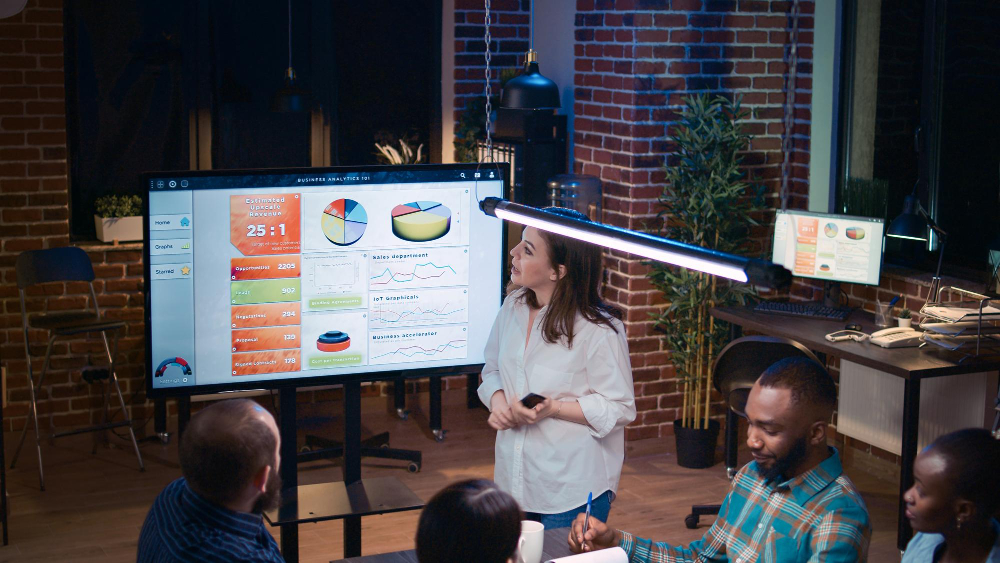Blog

Benefits of Room and Desk Booking Systems Post-Pandemic
The COVID-19 pandemic has drastically altered the landscape of work environments, propelling businesses to reassess their office space utilization strategies. Room and desk booking systems have become indispensable tools for managing flexible and safe workspaces in this new norm.
Evolution of Office Spaces Post-Pandemic
The pandemic forced many companies to adapt to remote work, but as conditions improve, a hybrid work model is emerging as the new standard. Offices are no longer static places but dynamic spaces that require intelligent management. The focus has shifted from fixed to flexible working arrangements, increasing the demand for room and desk booking systems.
What is a Room Booking System?
A room booking system is a specialized software that allows you to reserve meeting rooms, conference halls, and other spaces within an office environment. This is where space reservation software plays an integral role; it acts as the backbone that supports the smooth operation of a room booking system by offering features such as real-time availability checks, automated confirmations, and integrations with office calendars.
Benefits of Room and Desk Booking Systems
#1. Maximized Utilization
Room and desk booking systems ensure that every square foot of your office space is used efficiently. Such a system allows employees to see available spaces quickly, leading to better resource allocation. This results in more cost-effective use of spaces, supported by space scheduling software that tracks utilization patterns.
#2. Enhanced Flexibility
Flexible work hours require flexible workspaces. Room and desk booking systems allow employees to choose their desired workspace according to their schedules. This flexibility is often made more seamless through user-friendly space-booking software.
#3. Cost Efficiency
Maximizing cost efficiency with office space booking systems isn’t just about understanding space usage. It’s about actively leveraging insights and implementing strategies that minimize wasted resources and expenditures.
By implementing strategies and regularly monitoring the efficiency metrics, businesses can ensure they are extracting maximum value from their office spaces and minimizing unnecessary expenditures.
#4. Safety and Compliance
In a post-pandemic world, ensuring the safety of employees and maintaining compliance with health guidelines have never been more crucial. Space scheduling software can play a pivotal role in this endeavor. Here are several strategies and features to ensure utmost safety and compliance:
- Capacity Limitations: One of the most straightforward measures is to limit the number of people allowed in a particular room. The system can be set up to ensure that once a room reaches its adjusted post-pandemic capacity, it becomes unavailable for further bookings.
- Buffer Times: To minimize contact between groups, introduce buffer times between bookings. This window can be used to clean and ensure the space is ventilated, reducing the risk of virus transmission.
- Automated Health Screenings: Some advanced systems allow integration with health screening tools. Before confirming a booking, the system could require users to complete a quick health questionnaire, ensuring that anyone using the space is symptom-free.
- Virtual Check-ins: Avoid physical check-ins, which can lead to queuing or crowding, by introducing virtual check-ins through mobile apps. This minimizes contact and maintains a digital record for potential contact tracing.
- Visual Indicators: Use the system to highlight which desks or rooms are safe from others. By visually indicating which spaces adhere to social distancing guidelines, employees can make informed decisions on where to work.
- Regular Sanitization: Ensure that the system sends notifications to cleaning staff after a space has been used several times, prompting them for regular sanitation. This keeps the work environment clean and reduces the risk of contamination.
- Feedback System: Allow employees to report any safety concerns or breaches directly through the system. This can help in immediate rectification and keeps the management informed about potential areas of improvement.
- Training and Updates: Keeping employees informed about safety measures is essential. Use the system to push regular training modules or updates regarding safety protocols. This ensures everyone is aware of the best practices and recent guidelines.
- Integration with Air Quality Monitors: Some modern offices have air quality monitors. Integrate these with the booking system to ensure rooms with sub-optimal air quality are temporarily removed from the available list until the air quality improves.
- Clear Signage: While the digital system plays a major role, physical signage in the office, indicating safe practices, hygiene standards, and room capacities, can act as a constant reminder for employees.
Leveraging office space booking systems in these ways can drastically enhance office spaces’ safety and health compliance, ensuring businesses operate responsibly in the post-pandemic era.
#5. Seamless Collaboration
Coordination becomes effortless when employees can quickly book a room for impromptu meetings or collaborative sessions. Space scheduling software can book rooms in advance, ensuring that teams have the spaces they need when they need them.
What is a Hot Desk Booking System?
Hot desking allows employees to choose where they sit on a first-come, first-served basis. A hot desk booking system is a specialized version of space scheduling software that helps reserve individual desks rather than rooms. This promotes a dynamic work environment and is often facilitated by space booking software, making the process seamless and efficient.
Navigating the Office with Space Reservation Software
1. Digital Check-ins
How do you check in on office space? With space booking software, digital check-ins have become the norm. You can book a space and confirm your presence through a mobile app, eliminating any manual check-in process.
2. Integration Capabilities
Most room and desk booking systems can be integrated with existing office systems, providing a more holistic experience. This makes synchronizing with your email, calendar, and other professional tools easier.
3. User-Friendly Interface
A well-designed office space booking system will provide a user-friendly interface that helps employees make bookings easily and quickly. This not only saves time but also enhances team member satisfaction.
Challenges of Implementing Room and Desk Booking Systems
While space booking software has revolutionized workspace management, its adoption is challenging.
Challenge #1: Initial Setup and Integration
One major hurdle is integrating the new system into the existing office infrastructure. The system must be compatible with the company’s current software, including email and calendar systems. Organizations may also need to invest in hardware, like touchscreen displays in meeting rooms, further complicating the integration process.
Challenge #2: User Adaptation
Any new system can face resistance from employees, especially if they are transitioning from a more traditional, manual booking method. There’s a learning curve, and some employees might need help. This requires businesses to engage in training programs and ensure that their workforce understands the new system’s benefits to encourage its use.
Challenge #3: Maintaining Hardware
If the system relies on physical infrastructure like booking kiosks or tablets outside meeting rooms, these devices need regular maintenance. They’re prone to wear and tear, software glitches, or even theft, which can disrupt the booking process.
Challenge #4: Data Privacy and Security
Data security has become a paramount concern with the introduction of any digital tool. Space reservation software stores the personal information and preferences of employees. It’s crucial to ensure that this data is protected from breaches and that the software complies with global data privacy regulations.
Tips for Optimizing the Use of Room and Desk Booking Systems
To extract maximum utility from room and desk booking systems and address potential challenges, businesses can adopt several strategies:
Tip 1: Regular Training
Continuous education is the key. Periodic training sessions can help employees stay updated with the system’s features. This ensures the system’s optimal use and gives employees confidence in using it, thereby enhancing adoption rates.
Tip 2: Integrating with Other Tools
Integration doesn’t stop at email and calendars. Modern offices use many tools, from messaging apps like Slack to project management software. Integrating your room and desk booking system with these tools can streamline the booking process, allowing employees to book spaces without leaving their preferred platforms.
Tip 3: Feedback Loops
Continuous improvement is a two-way street. Encourage employees to provide feedback about the system. This can be invaluable in identifying pain points, understanding what’s working, and where improvements are needed. It also gives employees a sense of ownership and involvement in the system.
Tip 4: Regularly Review Analytics
Most sophisticated room and desk booking systems offer analytics on space utilization, booking trends, and more. Companies should routinely review this data to make informed decisions. For instance, if certain rooms are consistently overbooked while others remain largely unused, it might be time to reconsider the office layout or the functionalities of those spaces.
Conclusion
The post-pandemic world demands more flexible and efficient solutions for workspace management. Room and desk booking systems, supported by space reservation and scheduling software, offer a robust response to these demands. They enhance utilization and flexibility and pave the way for cost savings and adherence to safety guidelines.
Integrating these systems streamlines reserving spaces, reducing administrative overhead and enhancing user experience. Furthermore, they foster a more collaborative and organized environment, ensuring employees can seamlessly adapt to the changing dynamics of the workspace.
As we adapt to new ways of working, investing in these systems is less of a choice and more of a necessity for businesses seeking to optimize their operations in a rapidly evolving landscape.



















































 Support
Support  Demo
Demo  Blog
Blog 


